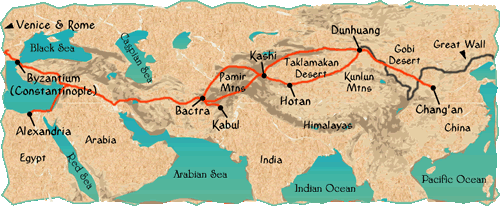Click Here to View the Main Index
Email....okarresearch@gmail.com
Rawak Stupa is a Buddhist stupa located on the southern rim of the Taklamakan Desert in China, along the famous trade route known as the Silk Road in the first millennium Kingdom of Khotan.
Aurel Stein first visited Rawak during his First Central Asian expedition in April 1901. At the site he found the large stupa which he described as 'by far the most imposing structure I had seen among the extant ruins of the Khotan region.' Part of the stupa, and almost all of the rest of the site, was covered by sand dunes, in places rising to about 25 ft. In places where the sand left the walls and structures uncovered, he found fragments of coloured stucco from the statues lying in the sand. His excavations over the following eight days uncovered 91 large stucco statues of buddhas and bodhisattvas, with smaller ones in between of attendant gods
"In his book Heart of Asia Roerich adds.....Not far from Khotan are many ruins of old Buddhist temples and stupas. One of these stupas is identified with the legend: That in the time of Shambhala, a mysterious light wll shine from it. It is said this light has already been seen."
"Khotan’s success, which was interdependent upon the strength of the Chinese Empire, the success of the Silk Road, and the proliferation of Buddhism, suffered great losses when all three began to decline. In the 10th century AD, the region witnessed the weakening of the T’ang dynasty in the East and invasions by Arabs in the West, who brought Islam to the area at the expense of Buddhist practices and art. Henceforth, while east-west trade continued, the once-flourishing Buddhist shrines were destroyed or replaced by those of Islamic culture. The ensuing instability as well as the rise of the Silk Sea Route caused traffic on the Silk Road to decline."......http://www.athenapub.com/9khotan1.htm
"The Dunhuang Caves......the monks of a nearby monastery heard about the fall of the Buddhist kingdom of Khotan to Karakhanids invaders from Kashgar in 1006 and the destruction it caused, so they sealed their library to avoid them being destroyed. The latest date recorded in the documents found in the cave is generally accepted to be 1002, and although other dates have been suggested, the cave was likely to have been sealed not long after that date."....http://en.wikipedia.org/wiki/Mogao_Caves
Portrait of a king of Khotan, Dunhuang Mogao Caves, 10th century
"During the reign of Ahmad b. Ali, the Karakhanids engaged in wars against the non-Muslims to the east and northeast. In 1006, Yusuf Kadr Khan of Kashgar conquered the Kingdom of Khotan.".......http://en.wikipedia.org/wiki/Kara-Khanid_Khanate
"According to legend, the foundation of Khotan occurred when Kushtana, said to be a son of Asoka, the Mauryan emperor, settled in Khotan about 224 BCE....Ashoka Maurya (304–232 BC) commonly known as Ashoka and also as Ashoka the Great, was an Indian emperor of the Maurya Dynasty who ruled almost all of the Indian subcontinent from ca. 269 BCE to 232 BCE.....Ashoka is referred to as Samraat Chakravartin Ashoka – the "Emperor of Emperors Ashoka." ....http://en.wikipedia.org/wiki/Ashoka
"The Shambhala teachings are transmitted through a lineage of seven great religious kings, and twenty-five kulika kings, or enlightened monarchs ( chakravartin)"......The Handbook of Tibetan Buddhist Symbols
"When Marco Polo passed through Turkestan in 1271 (fig.3) on his way to the court of Kublai Khan at Khanbalik (Beijing), he reported that Khotan - by then, long converted to Islam - still remained prosperous:.....Khotan is a province 8 days journey in width, subject to the Great Khan. The inhabitants all worship Mahomet. It has cities and towns in plenty, of which the most splendid, and the capital of the kingdom, bears the same name as the province, Khotan. It is amply stocked with the means of life. Cotton grows there in plenty. It has vineyards, estates, and orchards in plenty. The people live by trade and industry; they are not at all warlike.” [Marco Polo, Travels, chap. 33].
".....by the time of the Ming Dynasty (AD 1386-1644), the rivers that fed the basin had shifted or dried up. Concurrently, the Ming Emperors’ policy of isolationism drastically reduced the importance of the Silk Road. As a result, these ancient cities were abandoned to the desert elements, and buried by sand.".....http://www.athenapub.com/9khotan1.htm
"....While recovering at the nearby bazaar town of Khotan, Hedin learned of lost cities along abandoned riverbeds whose wooden house beams stuck out through desert sands, and of artifacts collected by local people. Within a few months he had visited several sites at Khotan and Niya, making limited excavations at houses and temples. Recognizing the significance of the finds which included Buddhist- and Gandharan-influenced carvings, paintings, and texts, well-preserved in the dry climate, Hedin reported them in both scientific and general publications..... Ruins of Niya house XXVI excavated by Stein. Fantastic animal effigies including winged beasts with crocodile heads are carved on wood panels (Stein 1912).".....http://www.athenapub.com/9khotan1.htm
Email....okarresearch@gmail.com
John Hopkins.....Northern New Mexico….June 2013




evebWim-ge Jamie Jackson https://marketplace.visualstudio.com/items?itemName=persginor-ru.Descargar-Pirate-Simulator-gratuita
ReplyDeletegiftfittiti
NboberYmonru Kimberly Vaughn https://www.redlac-af.org/profile/catalinaignazio/profile
ReplyDeletebrimogistor
Vsubsrupexyu Brayan Carroll site
ReplyDeleteBest
Install
pamounnueci